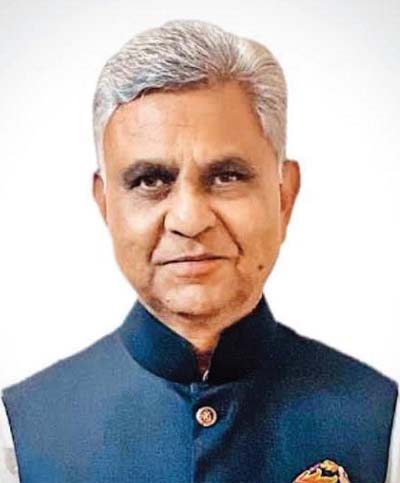The need for skilling or vocational education has been part of national policies on education since 1960s. Despite this “Skill-Gaps” have been a persistent problem in India.
There are 22 crore Indians who are in NEET category (Not in Education, Employment or Training). World Economic Forums (WEF) future of jobs report predicts 38% of Indian workers core skill will change by 2030.
Challenges in skilling include negative public perception, fragmentation in the sector, obsolete curriculum, shortage of trainers and demand supply mis-match. National policy for skill development and entrepreneurship 2025 aims to skill and certify 50% of labour force by 2035. WEF estimates 92 million existing jobs will be ‘displaced’ and 170 millions new jobs created by 2030.
30% of Indian companies are recruiting of the basis of skills, rather than degrees. Only 05 percent of workers in India are formally trained in their respective domains compared to 96 percent in South Korea.

IAS (Retired)
The Demographic Dividend
India is experiencing a demographic dividend with nearly 65% of the population below 35 years. However, employability is a major concern due to skill gaps, lack of industry alignment, and rural-urban disparities.
- Economic growth potential arising from a large proportion of population being in the working age group (15-64 years), with low dependency ratio of children and elderly.
- This window would last till 2055
- If managed properly, it can drive, A-Productivity, B-Savings, C-Investment
- If harnessed through, A-Education, B-Skill Development, C-Health, D-Employment Opportunities.
Realizing the urgency of providing jobs to large number of unemployed educated and school/college dropout youth and Gen-Z Our visionary Prime Minister of India, Narendra Modi Ji took a major initiative in 2014 by establishing an independent Ministry of Skill Development and Entrepreneurship (MSDE).
Hon’ble PM has set a national objective of making India as The Skills Capital of the World through national skill development mission.
Sadguru Jaggi Vasudev has observed that “If we don’t skill india we may as well kill india”.
Urgency of immediate steps
Recent happenings in Sri Lanka, Bangladesh and Nepal have highlighted that if the problem of massive unemployment being faced by Youth and Gen-Z in South Asia (including India) then even in India the “Demographic Dividend” could become a “Demographic Disaster”.
Catch Them Young
 Teaching tourism as a subject at the school and college level offers multiple academic, social, and economic benefits. It helps students understand their country and the world better while preparing them for future careers in a rapidly growing industry. Here’s a detailed list of benefits:
Teaching tourism as a subject at the school and college level offers multiple academic, social, and economic benefits. It helps students understand their country and the world better while preparing them for future careers in a rapidly growing industry. Here’s a detailed list of benefits:
- Awareness and Appreciation of Culture & Heritage
- Encourages students to learn about their own country’s history, heritage, geography, and culture.
- Fosters respect for diversity, tolerance, and understanding of different communities.
- Promotes a sense of national pride and responsibility towards preserving heritage sites.
- Early Career Orientation
- Introduces students to career possibilities in tourism, hospitality, travel, event management, and related services.
- Helps them develop basic knowledge and skills required for these professions, bridging the school-to-work gap.
- Aligns with vocational education and Skill India initiatives.
- Interdisciplinary Learning
- Integrates aspects of geography, economics, environment, culture, and management.
- Enhances critical thinking, communication, and problem-solving through project work and field visits.
- Promotes experiential learning by encouraging students to explore local destinations.
- Development of Soft Skills
- Improves communication, hospitality, teamwork, and leadership skills.
- Builds confidence and social etiquette, valuable across professions.
- Cultivates customer service mind set and empathy.
- Environmental and Social Responsibility
- Teaches students about sustainable and responsible tourism.
- Creates awareness about conservation of natural and cultural resources.
- Encourages community participation and local economic development.
- Economic and Entrepreneurial Awareness
- Highlights tourism’s role in economic growth, job creation, and foreign exchange.
- Inspires entrepreneurship in travel startups, homestays, eco-tourism, and local craft promotion.
- Promotes understanding of how tourism supports rural and regional development.
- Experiential and Enjoyable Learning
- Makes learning more engaging through field trips, excursions, and case studies.
- Provides practical exposure to planning, organization, and decision-making.
- Encourages creativity in designing itineraries, events, and promotional content.
- Alignment with NEP 2020
- Fits well with the National Education Policy (NEP) 2020 emphasis on vocational and experiential learning.
- Prepares students for holistic development and for careers in one of India’s fastest-growing sectors.
Schools in India already teaching hospitality & tourism under the direction/intent of NEP 2020 and related vocational frameworks.
 Status report — Schools teaching Hospitality & Tourism in India (NEP 2020 context)
Status report — Schools teaching Hospitality & Tourism in India (NEP 2020 context)
- Policy & framework — what enables school-level tourism education
- NEP 2020 explicitly pushes integration of vocational education with general schooling (every child exposed to at least one vocation from Class VI onward), creating the policy mandate for school-level hospitality/tourism modules.
- The National Vocational Education Qualification Framework (NVEQF/NSQF) and sector skill councils (Tourism & Hospitality Skill Council) provide competency standards and National Occupational Standards (NOS) to align school training with industry needs.
- What’s already in school curricula (national boards / samples)
- CBSE has developed and published vocational syllabi and curricular materials for tourism (e.g., “Introduction to Tourism” for classes IX–X and hospitality packages for senior secondary), and lists hospitality/tourism among its school vocational packages. These curricular documents are available for affiliated schools to adopt.
- Extent of implementation—pockets of adoption, not universal rollout
- Implementation is patchy: several CBSE and state schools run hospitality & tourism vocational modules (often as NSQF-aligned courses), but nationwide rollout is incomplete — adoption depends on board affiliation, state education efforts, availability of vocational teachers, and infrastructure. Research and survey reports note progress in some states and significant implementation challenges in others.
- Example: state NSQF school lists (for example, Haryana’s public listing) show individual government schools registered to deliver Tourism & Hospitality vocational packages — indicating state-level, school-by-school adoption rather than blanket coverage.
- Human resources & teachers
- Many states and local bodies continue to rely on part-time vocational teachers (PTVTs) to run hospitality/tourism streams; some recent state actions have extended/regularised such teachers (e.g., Delhi extensions for PTVTs including in Hospitality & Tourism). This reflects both progress (trained instructors exist) and fragility (contractual staffing, variable remuneration).
- Industry linkages & standards
- The Tourism & Hospitality Skill Council / NSDC provide industry-aligned courses and National Occupational Standards used by schools and training partners — enabling internships, assessments, and smoother transition to skilling pathways. Many schools that teach tourism rely on NSDC/THSC standards or partner training organisations.
- Gaps & constraints (widely reported)
- Infrastructure: practical labs, kitchens, site visits, and equipment are often lacking in many schools.
- Teacher availability & quality: insufficient number of trained vocational teachers; many employed on short-term contracts.
- Uneven state uptake: some states and CBSE clusters have active programmes; others have little implementation.
- Industry engagement: variable — where strong, students get internships and placement pathways; where weak, training remains theoretical.
- Signs of momentum & good practice
- Updated CBSE curricular materials (e.g., 2023–24 “Introduction to Tourism”) show curricular readiness for wider adoption.
- State initiatives (career portals, skill mapping) and NSDC/THSC training partners show growing ecosystem support for school-to-work linkages.
- Recommendations (for education departments/ schools)
- Map existing schools running tourism/hospitality (use • NSQF/CBSE/State lists) and prioritise scale-up in tourism-rich districts.
- Convert PTVT roles to stable appointments or ensure recurring funding to retain skilled vocational teachers.
- Use NSDC/THSC occupational standards for assessment, and formalise industry internships with hotels, travel agents, and attractions.
- Provide minimum infrastructure grants (basic demo kitchen, service tools, local field visits) and modular teacher training.
NEP 2020 created the policy window and direction for tourism & hospitality at school level; implementation exists but is uneven — visible where CBSE/NSQF frameworks, state lists and NSDC linkages are active, but limited by teacher contracts, infrastructure and variable industry engagement. Concrete scale-up will require systematised mapping, funding for infrastructure and teacher regularisation, and formal industry partnerships.
 Global scenario and successful case studies
Global scenario and successful case studies
Several countries have successfully made tourism education part of school curricula, producing skilled, culturally aware, and globally employable youth. Here are the best international role models India can learn from:
- Switzerland – Global Benchmark
Model: “Swiss Tourism and Hospitality Education System”
- Integration from school to university: Students are introduced to tourism and hospitality concepts as early as secondary school.
- Focus areas: Practical training, multilingualism, cultural understanding, and hospitality ethics.
- Outcome: Switzerland produces world-class tourism professionals, and its schools (like EHL, Les Roches, Glion) are global leaders.
- Key lesson for India: Blend theory with hands-on learning, apprenticeships, and strong industry linkages.
- New Zealand – Sustainable and Experiential Learning
Model: Tourism as part of “Vocational Pathways” in schools
- Focus: Ecotourism, Māori culture, sustainability, and local heritage.
- Approach: Outdoor education, local community projects, and digital tourism promotion.
- Outcome: Students graduate with employable skills and deep respect for nature and culture.
- Key lesson for India: Emphasize eco-tourism and community involvement.
- Singapore – Early Career Mapping
Model: “Applied Learning Programme” in tourism and hospitality
- Focus: Tourism introduced through real-world projects, field visits, and industry partnerships (e.g., Sentosa, Changi Airport).
- Outcome: Students identify career interests early and gain strong communication and service skills.
- Key lesson for India: Create school–industry partnerships and practical exposure early on.
- Spain – Cultural Tourism and Heritage Focus
Model: Tourism modules in vocational and high school curricula
- Focus: Heritage tourism, gastronomy, and destination marketing.
- Outcome: Strong local tourism workforce sustaining Spain’s global tourism leadership.
- Key lesson for India: Link regional crafts, cuisine, and heritage with school learning.
- Thailand – Community-Based Tourism Education
Model: “One Tambon One Product” and tourism education programs in schools
- Focus: Local tourism, handicrafts, and sustainable livelihood creation.
- Outcome: Students contribute to rural tourism entrepreneurship and local economic development.
- Key lesson for India: Promote local tourism enterprises and cultural pride from school level.
- Australia – Vocational Tourism Pathways
Model: Tourism within the “VET in Schools” framework
- Focus: Skill-based training, internships, and industry certifications.
- Outcome: Smooth transition from school to professional tourism and hospitality roles.
- Key lesson for India: Integrate NSQF (National Skills Qualification Framework) levels with school subjects.
Indian success story (National initiative for skill integrated Higher education (NISHE))
Centre for Research in Schemes and Policies(CRISP): CRISP is a non-profit society under the societies registration ACT 1860 as per section 20 of the ACT (with All India Jurisdiction) with headquarters at Hyderabad (Telangana).
CRISP has launched a unique project in 08 states for integrating high order skills (including tourism and travel management) in Higher education.
UGC guidelines issued in July 2020 has advice and recommended Apprenticeship Embedded Degree Programmes (AEDP) in all Indian universities on high priority basis.
Ministry of education, Govt. of India piloted skill-embedded degree programs in selected sectors in Academic year 2018-19.
CRISP is implementing NISHE in following 10 states namely Maharashtra, Karnataka, Tamil Nadu, Uttar Pradesh, Telangana, Rajasthan, Madhya Pradesh, Andhra Pradesh, Odisha and Himachal Pradesh.
The sectors covered are IT & ITes, BFSI, Logistics, Tourism & Hospitality, Health care, Retail, Life sciences, Media & Entertainment, Fashion Design. Electronics and Capital Goods covering 1433 colleges in these 10 states.
The Way forward
In the spirit of NPE-2020, Indian Govt. and State Governments in collaboration with CBSE/UGC should immediately accelerate the process of integrating skill education in general and Tourism and Hospitality Education in particular at school and college level.
Gen-Z is ambitious, talented, educated and fairly impatient, Hence in addition to educating them we must ensure that they are taught Hands-on employable skills to get them jobs and rewarding careers as soon as they pass out of schools/colleges.
If we, as a nation don’t act on this issue on highest priority than Gen-Z activism recently witnessed in our neighbouring countries like Nepal and Sri Lanka may be knocking at Indian shores not in a very distant future.








